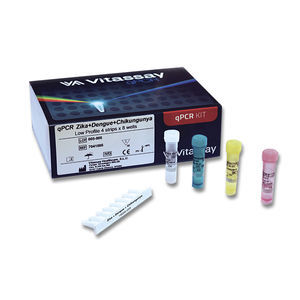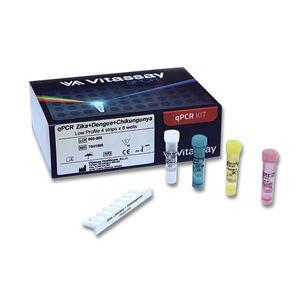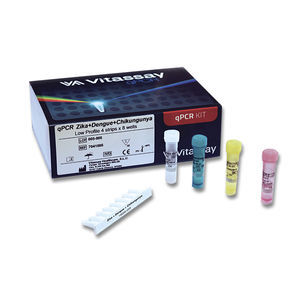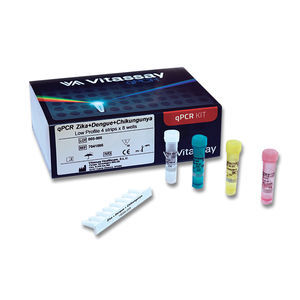
- Laboratory
- Laboratory medicine
- Infectious disease test kit
- VITASSAY HEALTHCARE S.L.
Sexually transmitted disease test kit 7041037for infectious diseasesHPVclinical
Add to favorites
Compare this product
Characteristics
- Applications
- for sexually transmitted diseases, for infectious diseases
- Micro-organism
- HPV
- Sample type
- clinical, laboratory
- Analysis mode
- for real-time PCR
Description
Vitassay qPCR HPV allows the detection and differentiation of human papilloma virus 16
and 18 by real-time PCR in clinical samples. The product is intended for use in the diagnosis of human papillomavirus 16 and 18 infections alongside clinical data of the patient and other laboratory tests outcomes
Transport and storage
• The reagents and the test can be shipped and stored at 2-40ºC until expiration
date stated in the label.
• The resuspended positive control should be stored at -20ºC. In order to avoid
repeated freeze/thaw cycles, it is recommended to distribute the content in
different aliquots.
• Keep all reagents in the darkness.
Additional equipment and material required
• DNA extraction kit
• Real-time PCR instrument (thermocycler) (Attached I)
• Centrifuge for 1.5 ml tubes
• Vortexer
• Micropipettes (1-20 µl, 20-200 µl)
• Filter tips
Summary
Human papilloma virus (HPV) is responsible for the most frequent sexually transmitted
infection (STI) of the reproductive tract. This virus is so common that almost all sexually
active women and men contract it at some point in their lives.
More than 200 types of HPV are known and have been classified predominantly in three
genera: Alpha-papillomavirus, Beta-papillomavirus and Gamma-papillomavirus. Among
the 65 HPV types belonging to Alpha-HPV, there are 15 genotypes most frequently
associated with cervical cancer cases, called high-risk HPV (HPV-16, 18, 31, 33, 35, 39,
45, 51, 52, 56, 58, 59, 66, 68 and 82), type 16 is the responsible for more than 50% of
cases of squamous cell carcinoma.
Catalogs
Vitassay_Catalogue
20 Pages
Related Searches
- Assay kit
- Solution reagent kit
- Blood assay kit
- Molecular biology reagent kit
- Plasma assay kit
- Infectious disease detection kit
- Blood rapid diagnostic test
- Diagnostic reagent kit
- Rapid lateral flow test
- Enzyme reagent kit
- Immunoassay rapid diagnostic test
- Molecular test kit
- Cassette rapid diagnostic test
- Virus rapid diagnostic test
- Respiratory infection test kit
- Optical assay kit
- Clinical assay kit
- Infectious disease rapid diagnostic test
- Buffer solution reagent kit
- Fluorescence assay kit
*Prices are pre-tax. They exclude delivery charges and customs duties and do not include additional charges for installation or activation options. Prices are indicative only and may vary by country, with changes to the cost of raw materials and exchange rates.





















